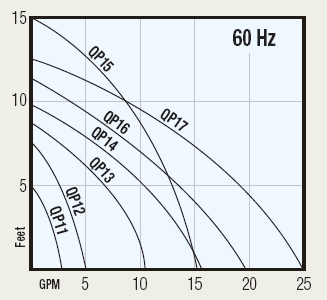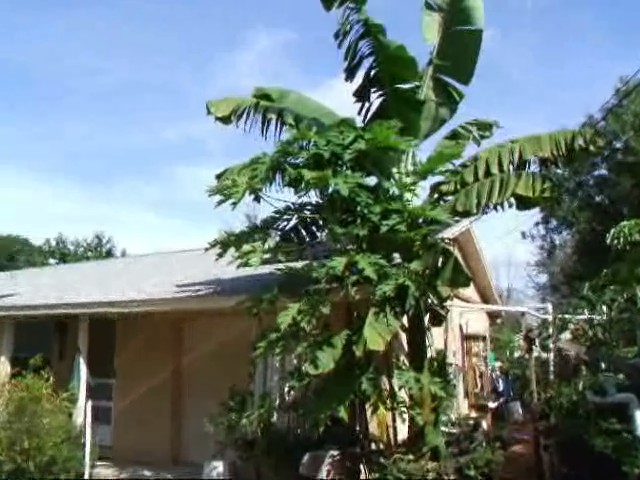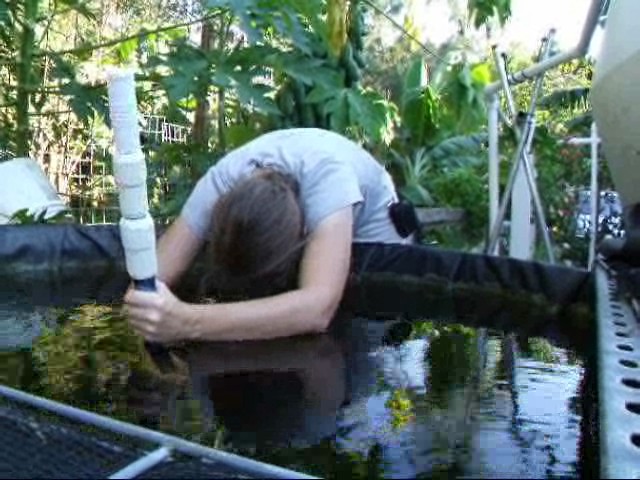So you are designing an aquaponics system but how do you figure out what pump size to use?
There are some simple minimum rules of thumb that can help. For media bed aquaponics design it is generally recommended to pump at least the volume of your fish tank each hour (and I usually pump more than that in my systems.)
So the first step in choosing a pump size is knowing your fish tank volume. Say you have a 300 gallon fish tank so you know you want to move at least 300 gallons per hour.
Then you will also need to know how high you need to lift the water. A pump that is called a 300 gph pump will generally move far less than that if you ask it to be lifted at all. So measure from the surface of the water where the pump will be situated (if the pump is in a sump tank that will fluctuate in the extreme, then you can simply measure from the low water level at the pump intake) up to the highest point to which the pump needs to lift the water which will often be either just above the rim of the grow beds or the fish tank depending on the system design.
For example say you are lifting the water 3 feet.
Now it’s time to go looking for pump curves as these are very important in figuring out pump size. All good pumps should tell you how much water they will pump at different heights, if they won’t share that information, don’t buy the pump.
So by doing a little math one can figure out that the QP14 will move 600 gallons of water an hour at 5′ of head. So if the pump was going to run 30 minutes out of each hour, then this pump would be adequate to handle our 300 gallon fish tank example at 3′ head. If the pump was going to run constantly then the QP13 would be adequate to our example system. Notice that I tend to allow for some extra capacity on the pump since there will also be some pipe friction to overcome.
If for our Aquaponics example the pump is planned to run only 15 minutes each hour, then we need a pump that will move 4*300 per hour at 3′ head or 20 gallons per minute. The only choice left on this pump curve would be the QP17.
My 300 gallon Aquaponics system runs with a repeat cycle timer that has the pump on for 9 minutes then off for one minute and I’m lifting the water about 30 inches. So I’m pumping for 50 minutes per hour and I’m using the QP14 so I’m probably pumping almost 600 gallons per hour for that system and this seems like a fine thing to me.
If you choose an energy efficient pump then pumping extra water will only cost a little extra in electricity and may save you quite a bit in keeping your water quality nice.






Your website is very helpful.
I understand figuring the basic pump size based on the tank size, but where does the height come in on the calculation?
Thanks,
David
dhoward81@sbcglobal.net
You should be able to find curves or charts for most good pumps that will tell you how much they can pump at different heights above the water in the tank the pump is in or drawing from. So if you are pumping from a tank that is 4 feet below where you are pumping to, then you want to make sure your pump will provide enough flow at 4 feet of head.
Just because a pump is rated for say 1000 gallons per hour that usually means at 0 head. And when they give a max pumping height of say 12 feet, that means the pump will probably not actually pump any more water at 12 feet of height.
Hope this helps
Do these numbers reflect the use of an air pump? Thanks in advance Jim
I generally design so that I’m moving at least the volume of my fish tank each hour AND using some other supplemental aeration in addition. While I’ve found that when the weather is cool and/or when stocking is really low, the air pump/other supplemental aeration might not be mandatory, it is generally helpful during hot weather or when stocking or feeding is especially heavy.
Also, a separate method of supplemental aeration provides a measure of backup in case of main system pump failure. I usually also run the supplemental aeration on a battery backup in case of power failure.
This article. Was very interesting. Thanks I think I got it hopefully the friction of the pipes don’t have to much impact whenever I’m ready to buy the pump.
That is one reason for going with larger pipes since then you will have less friction loss in the pipes.
Your contributions both on your website and on various blogs are extremely helpful. One thing I’ve often found lacking in clarity (though you are stating it quite clearly) is that some authors talk about cycling the water in your system (fish tank plus hydroponic part)once per hour, whereas you state the water in your fish tank once per hour. In a system incorporating floating rafts for growing primarily salad greens, that adds up to a ridiculously sized pump! Can you clarify, if the only parameter to be considered is the fish tank volume (provided of course the nutrient supply is sufficient to meet the plants’ demand), or is there any limit to keep in mind for circulation in the hydroponic portion of the setup?
Thanks in advance!
While I’m not extremely experienced in Raft culture, I have read plenty that supports the raft beds only need about 5 gallons per minute of flow through them (that is only 300 gallons per hour flowing through the raft beds). You probably shouldn’t do more than 200 feet of 4 foot wide run per than amount of flow.
I say you need to pump at minimum the volume of your fish tank, through your fish tank per hour and a good portion of that water should be getting filtered. That is personal opinion there are calculators out there where you need to know fish mass and amount of fish feed etc and they tell you how much water turn over you need but for a “backyard” system that is not being overly stocked and needs to be easy to figure and operate, just make sure you are pumping AT LEAST the volume of the fish tank (all fish tanks) and make sure your pump can move that volume AT the HEIGHT needed. A pump that is called a 300 gph pump on the box generally only moves 300 gph at 0 head height. As soon as you lift water and restrict it through pipes you loose some flow so you need to find the chart that tells how much water a pump will move at the height required. And then go a little bigger since you are usually also pumping through pipes.
You don’t count the water volume in the DWC or raft beds when figuring pumping. Water volume in those kinds of beds only really needs to be figured when you need to know the total system water volume for figuring things like dosing iron or salt or heating/cooling BTUs. The raft beds only need about 5 gallons per minute through them, they can take more as long as the plumbing allows the flow without overflowing.
Thanks, that makes good sense. I am planning filtration and was also thinking of incorporating a small dutch bucket system before the raft to provide some additional media filtration.
Do you have any experience or have heard of anyone using a dutch bucket system with aquaponics. Saw a pretty interesting video on YouTube of someone using the same with hydroponics, which has inspired me to try. Don’t see any reason why it wouldnt work with aquaponics. Would really appreciate your opinion before I go out and start buying buckets.
Thanks in advance!
I’ve heard of people doing dutch buckets but I don’t have experience with them myself.
The amount of filtration you will get from dutch buckets could be minimal depending on the TYPE you set up. Drawbacks with dutch buckets have to do with needing a lot of extra plumbing fittings and small fittings are likely to clog if you are using un-filtered water to feed them.
I have a 12,000 gal. fish pond, I have koi and goldfish in it , they have been balanced and doing very well for 6 years . I am going to divert some water from the filter and falls to some 4×8 grow beds (4 beds) I had planned to use a 1″ line with a ball valve to fix the flow. my existing pump cycles my pond volume every hour. Im hoping the extra filtration from the beds with 1/2 inch rock will be good. If you have any advise I would love to hear, doing things over is never fun. thank you
If your existing pond is already perfectly balanced, I don’t know if there is much benefit to the pond in having more filtration or if there will even be much in the way of nutrients left over for your veggies in Aquaponic beds.
I would recommend running some water tests to check for Ammonia, Nitrite, Nitrate and pH. If you are having to do water changes to keep things balanced then having the veggies in the system may reduce or eliminate the need for water changes but if you never do water changes and you don’t have problems with nutrient build up, then you may be disappointed with the results. Make sure your 1/2″ rock will not affect pH.
thank you, the summer heat here does do a number on the system, so that’s why I was going to do the veggies, also if I add catfish for food supply. I will test the rock it is not limestone based I believe. I will test with vinegar. thanks for the response.
Biggest challenge with making aquaponics work on a larger body of water is that Algae can get out of hand. Most “tank” based aquaponics systems can use some form of cover over the fish tank to block out light and deal with the algae problem but in a large ornamental pond, swimming pool, or natural pond/lake you don’t really get to Cover the whole thing to stop an algae bloom. Dosing with seaweed extract may reduce algae some but it also tints the water dark brown and is not necessarily desirable for an ornamental pond since you won’t be able to see the fish well. Good Luck with the project, I think I can be done but it is definitely trickier and I don’t have experience with figuring out the balance and design.
thank you, I was hoping it would help with the summer but we will have to have ponds ready just in case the koi pond wont work
It is worth a try and it just might work, I can’t really give much advice on how to make a large ornamental pond aquaponics system work or balance or even how best to cope with Algae or too low a nutrient level since I just don’t have the personal experience with such systems.
I want to make and in ground tank that is going to hold 2700 gallons up to some heavy duty filters and back down into DWC beds that span 20 ft long along side the tank and back down into the tank. So all im going to need is a pump that can move all the water from my tank so a 3000GPH pump should do?
if your pump will move 3000 gph at whatever height you will need to pump to, it will be just enough.
There is no guarantee that a 3000 gph pump will move 2700 gph if you don’t look at the amount it actually pumps at different heights.